Connecting Generations: L'Dor Vador with Jewish Folktales
By: Clare Kinberg |
Posted on: March 08 2019
About this series: JewishLearningMatters.com is excited to feature the expertise of librarians in Jewish schools. If you are a Jewish educator working as a librarian, please consider submitting an article, details here.
For the last seven years, each Shabbat morning during the school year, I have read stories to our religious school classes, preschool through fifth grade, at Temple Beth Emeth (Reform) in Ann Arbor Michigan. When I choose a Jewish folktale to read, I find myself and my students transported around the world and through time on a magic carpet of our ancestors' weaving. I have been delighted to learn that a well told and illustrated folktale communicates a pardes: a garden of Jewish learning, even to early elementary students. As I read to them, I believe I can almost see the primordial light shining from the students' faces. While they are listening to an entertaining tale, they open to glimpses of the Jewish past, as well as the values and faith that sustain us.
I usually begin by reminding the students that over time, Jews have lived in every corner of the earth, perhaps, at some time, in all 200 countries of the world. We look at the pictures in the book for clues to where the story is taking place. Is it an Eastern European shtetl, a village in Algiers, old Tzafat? We look at the architecture of the buildings and the clothes the people wear. Sometimes I even show them a map, especially when, as folktales often do, the story involves a journey (A Cloak for the Moon, Letter on the Wind, The Sabbath Lion). We think about when the story is happening. Is it long ago, in the time of their (great) grandparents? Or is it long, long, ago, or even long, long, long ago? Thus, the students are settled in for a story that has a real place, even if far away, and a real time, even if long ago.
Each story has an ethical message that is fairly close to the surface: It is good to be kind, it is right to observe the Sabbath, stand up for your beliefs, families care for one another. I might discuss this aspect of the story before or after I read it. For The Rabbi Who Flew, I ask the students if they have ever felt embarrassed. "No, don't raise your hand. I don't want you to embarrass yourself again, just think about it to yourself." Before Much, Much Better, we discuss whether or not they have younger siblings, do they have a baby in the house who needs special care.
Each of the folktales then proceed to tell a fantastical story, a rabbi who is so kind and pious he lifts off of the ground when he davens, a tailor finds cloth woven from moonlight, a giant lion gives a young boy a ride across the desert, or a clairvoyant stranger visits a poor family. The strangeness of the story keeps the students listening, encouraging a suspension of what they think they know. They almost lift off of the story rug, trying to understand what this wild story could possibly be about.
Invariably, as I close the book, one of the Kindergartners through third graders will ask, "Is that true? Did that really happen? Is that fiction?" I love that question. It's my cue to ask them, "Something about this story is true, what do you think it is?" This part of the discussion is unpredictable, sometimes I am surprised by what the students think could "really happen" and what they find impossible to believe. I try not to answer myself; I know that each time I read a good folktale, a different truth is revealed. The question, though, lets the students know that there is something hidden in the story, something that their ancestors wanted them to know, and that they will have to think to find out what it is.
To bring the reading to a satisfying conclusion, I generally reiterate a simple ethical message from the story. For instance, in Much, Much Better, children are a blessing; in The Wooden Sword, be happy with what you have; in A Cloak for the Moon, keep your promises; in The Sabbath Lion, keep the Sabbath. I hope they will return to the story many times in their lives, each time learning something new.
Jewish folktales transmit our heritage on several levels, from the past to the future L'dor vador.
These are Clare's favorite picture books for exploring the Jewish value of connecting generations, l'dor vador. Please check out our L'dor Vador Resource Page to find additional and complementary lessons, songs, videos and more.
___________________________________________________________________________________________________________
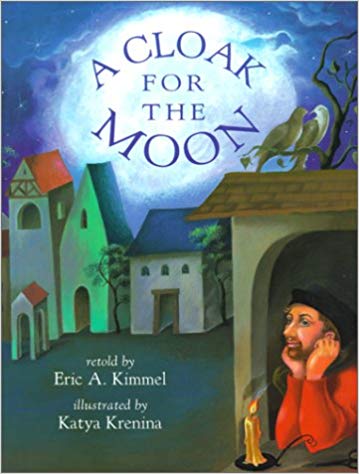 A Cloak For The Moon
A Cloak For The Moon
Ages: 5-8
A retelling of one of Rabbi Nachman's tales in which a tailor, dreaming that the moon is cold in the sky, goes in search of a special fabric with which to make it a cloak. Haskel, the tailor, travels far and wide in search of a magical garment woven with threads of light, which perfectly fits the seemingly cold moon.
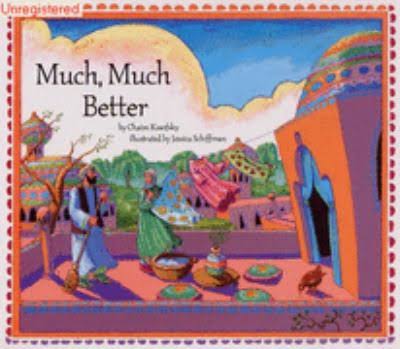 Much, Much Better
Much, Much Better
Ages: 3-6
Shlomo and his wife, Miriam, live in a bright, tidy house in the ancient city of Baghdad. The couple's greatest joy is welcoming guests for Shabbat. But one week, there isn't a single poor or lonely person who can join them. When a mysterious traveler knocks on their door, Shlomo and Miriam treat him royally. Then, before he leaves, the grateful guest blesses the couple with the strangest bracha they've ever heard:
Your home would be better with a sticky stained tablecloth.... And it would be much, much better with crumbs scattered on the floor.
The two of them can't help wondering: what will happen next?
Based on a tale of Eliyahu Hanavi, this beautiful story of hidden blessing is a heartwarming treat for the entire family.
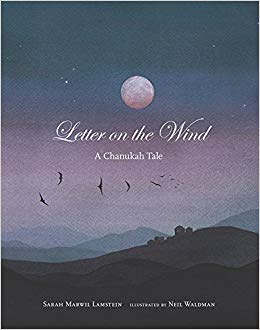 Letter on the Wind: A Chanukah Tale
Letter on the Wind: A Chanukah Tale
Ages: 6-9
A retelling of a Jewish folkale reminds readers of the first Chanukah and of Mattathias's bravery in protecting his faith. Once in a far-off village there nearly was a year without Chanukah. The withering olive trees produced to olives for oil, and without oil there would be no lights for the menorahs. Hayim, the poorest man in the village, said to himself, "We cannot have a year without Chanukah. I will ask the Almighty for help." Despite mockery and laughter from the villagers, Hayim asks the local scribe to write a letter to the Almighty. In it, Hayim prays for oil to light the town's menorahs. The poor man takes his letter to the highest hill and sends it off on the strongest breeze. Hayim's prayers are answered, and the villagers can celebrate Chanukah—but many in the town are convinced that Hayim is a thief.
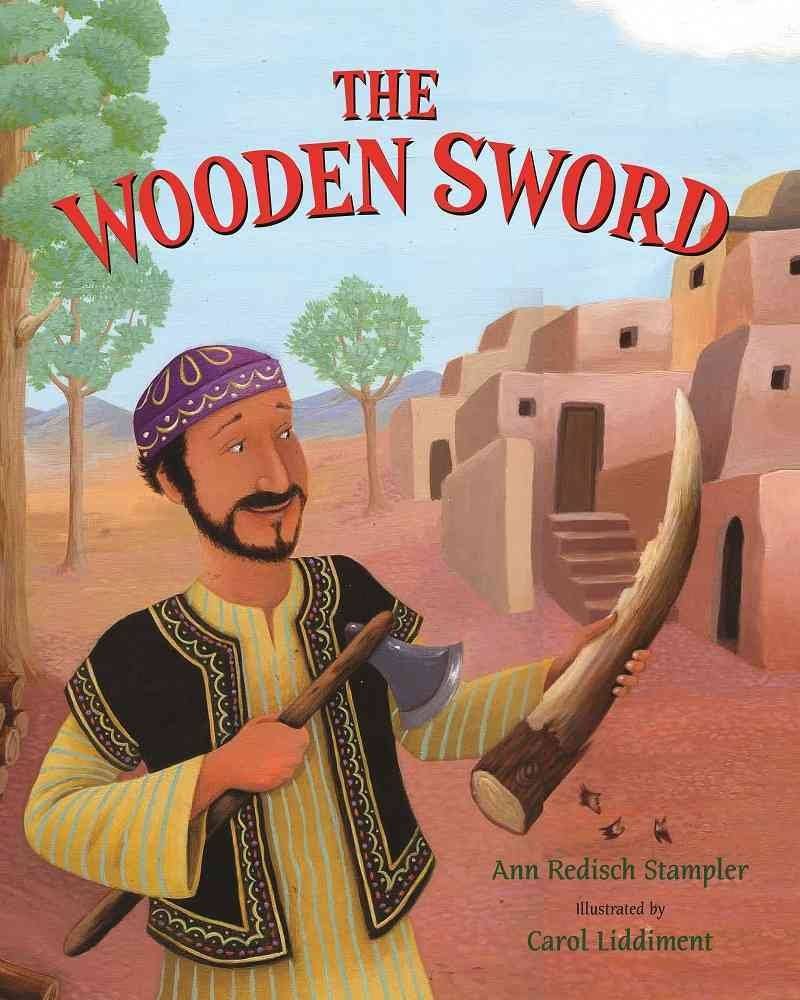 The Wooden Sword: a Jewish Folktale from Afghanistan
The Wooden Sword: a Jewish Folktale from Afghanistan
Ages: 5-8
Disguised in servant's clothes, an Afghani shah slips out of his palace to learn more about his people. When he encounters a poor Jewish shoemaker full of faith that everything will turn out just as it should, the shah grows curious. Vowing that no harm will befall the poor man, he decides to test that faith, only to find that the shoemaker's cheerful optimism cannot be shaken.
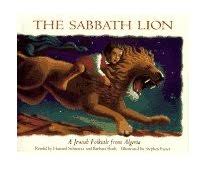
The Sabbath Lion
Ages: 5-8
Yosuf starts off for Egypt, to claim his family's inheritance, but--when the caravan leader insists on traveling on the Sabbath--Yosuf fears he will die in the desert
*This is also a great story to explore courage- check out this book guide from PJ Library for more ideas to extend the exploration this story can prompt.
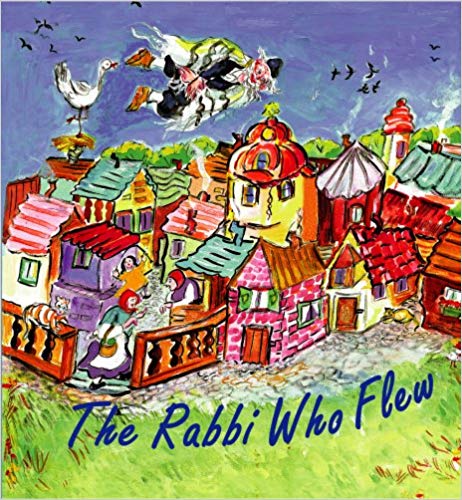 The Rabbi Who Flew
The Rabbi Who Flew
Ages: 6-8
Grandma Hanne Sheyne tells the story of Rabbi Frum, a man who prayed so deeply that he flew, and of the villagers who watched in amazement.
 About the contributor: Clare Kinberg is the librarian at Temple Beth Emeth, Ann Arbor; Director of the Ann Arbor Reconstructionist Congregation Religious School; and the Editor and publisher of the Washtenaw Jewish News.
Kinberg was managing and general editor of Bridges: A Jewish Feminist Journal from 1990-2011. Born in 1955 in St Louis, she has also lived in Brooklyn, Seattle and Eugene, OR.
About the contributor: Clare Kinberg is the librarian at Temple Beth Emeth, Ann Arbor; Director of the Ann Arbor Reconstructionist Congregation Religious School; and the Editor and publisher of the Washtenaw Jewish News.
Kinberg was managing and general editor of Bridges: A Jewish Feminist Journal from 1990-2011. Born in 1955 in St Louis, she has also lived in Brooklyn, Seattle and Eugene, OR.